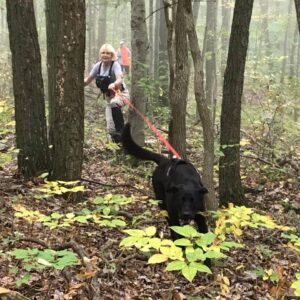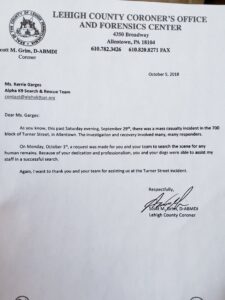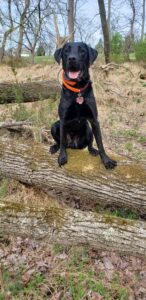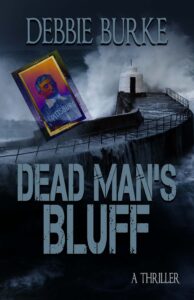By Debbie Burke
Gruesome Warning – This post contains graphic details of a horrific bombing that killed three people, including a two-year-old child.
Dogs are helpmates that do most anything their people ask of them…including jobs that no one, human or animal, should have to do…like finding body parts after an explosion.
Kerrie Garges has spent nine years as a volunteer dog handler for Alpha K-9 Search and Rescue (SAR) in Chalfont, PA, population 4,000. Until the COVID 19 crisis, her day job was teaching environmental education at Peace Valley Park Nature Center in Bucks County.
She fell into SAR “by accident” as a dog-loving empty-nester looking for a way to help her community. At a training exercise with her then-new Labrador, Ace, the instructor observed that Ace showed an aptitude for “air scent” (tracking smells through the air rather than on the ground) and invited her to join SAR.
Ace, age 10, is now retired but Kerrie continues to train and work with two more Labs: Luna, age 5, is Trailing Certified and is training for Human Remains Detection (HRD). She practically yanks Kerrie’s arm out of the socket when she’s on the hunt.
Gauge is Kerrie’s rambunctious one-year-old about which she jokes, “Just shoot me in the head!” He’s gradually growing out of puppyhood as he trains for certification in Live Find and HRD. She says, “When Gauge has his vest on, he knows he’s working.”
Most searches Kerrie has worked involve people with dementia who’ve walked away from home and gotten lost.
A completely different—and hideous—search would test the mettle of Kerrie and other dog handlers who were called in by the Lehigh County assistant coroner to work a murder-suicide crime scene in 2018.
On September 29, at 9:30 p.m., an explosion shook the Center City neighborhood in Allentown, PA. The cause was initially believed to be a car fire. First responders instead found that a powerful homemade bomb had detonated inside a car, killing three people and damaging surrounding buildings and homes for blocks.
Investigation determined the bomb had been built by Jacob G. Schmoyer, 26, with the express intention of killing himself, his two-year-old son Jonathan (“JJ”), and a casual friend David Hallman, 66, to whom Schmoyer owed $150. Before the explosion, Schmoyer had sent letters to family members and the Allentown Police Department in which he expressed anger as well as concern that JJ might have autism.
That night, Schmoyer lured Hallman into his Nissan Altima, where he and JJ were already sitting, with the promise to pay back the money.
Instead, he detonated the bomb which killed the three occupants, shredded the car, and cast debris and body parts over a five-block area.
Following the initial investigation, Lehigh County’s assistant coroner requested help from Alpha K-9 SAR to locate human remains amid the rubble. Kerrie said, “We’re a small group without a lot of resources, so we were honored to be called for this important mission.”
For this job, Kerrie did not bring her own dogs, which are still in training. Dogs must be tested and certified by National Association of Search and Rescue (NASAR) to perform real-world work. Kerrie acted as a support person to handlers and three dogs that are certified in HRD.
On the morning of October 2, the Alpha K-9 SAR volunteers arrived in Allentown, an hour’s drive from Chalfont. An eight-block area had been cordoned off. They were escorted past crime scene tape into destruction that Kerrie described as “a war zone.”
Following the blast, residents of surrounding blocks had been evacuated. Broken glass, tree limbs, chunks of buildings, and hazardous debris were everywhere, causing Kerrie concern because the dogs didn’t have protective footwear. Coroner’s office personnel offered to adapt the knee-high protective coverings that humans wore to fit the K-9s. After discussion, the handlers decided that, since the dogs weren’t accustomed to working with booties, wearing them might be too distracting. They closely monitored the dogs’ paws but fortunately there were no injuries.
Kerrie expressed “new respect for disaster dogs” working under similar dangerous conditions.
The day was hot and coroner’s office personnel made sure the volunteers and dogs had extra water and could cool off in air-conditioned vehicles when necessary.
The densely-populated, inner-city area of Allentown contrasted sharply with the suburban schools, parks, and rural locations where the Chalmont team normally worked. Older houses were crowded together, many converted to multi-family apartments. Narrow passageways called “bakers alleys” separated the buildings.
Adjacent to the cordoned-off crime scene area, Kerrie smelled meth cooking. Although law enforcement was nearby, she was startled to see bystanders carrying on drug deals and smoking marijuana. Those scents, mingled with dust and smoke caused by the explosion and fire, created a confusing mix for the dogs to sort out. She said, “It took about twenty minutes for them to get acclimated to the scene” in order to focus on finding human remains.
The coroner’s office created a map of the areas to be searched. Each dog team was assigned a different sector. Coroner’s assistants accompanied the teams, taking photos of pieces of burned flesh as they were found. The evidence was then “bagged and tagged” and taken to the crime lab.
One dog kept wanting to climb over a stone wall to get into a particular house. Inside, the searchers found shattered windows and furniture overturned by the explosion. A TV was still on, forgotten when residents quickly evacuated. The team also found a frightened puppy that had been left behind, tied up with no food or water. “That bothered me a lot,” Kerry said. Officers carried the pup to safety.
As they proceeded through the area, the dogs kept raising their heads, looking up, which mystified the handlers who couldn’t see anything. At last, they discovered “a giant flap of flesh” stuck high in the gutter of a four-story building, a horrifying indication of the power of the blast.
“We [searchers] felt disgust,” Kerrie said. “Not stomach-churning kind of disgust but rather mental and emotional disgust that the man had killed his little boy and his friend and caused all these poor people to be ousted from their homes and businesses.”
The search lasted four hours and located human remains as far away as five blocks from where the bomb had exploded. Each dog found at least three pieces, the largest being the flap of flesh in the gutter. The smallest was a charcoal-colored, wafer-thin piece of burned flesh the size of a quarter. Kerrie recalled, “I’d watched a documentary about [the atomic bomb at] Hiroshima and that’s the first thing I thought of when I saw this piece.”
Even veteran law enforcement officers were shaken by the devastation and the senseless death of a toddler. Counselors were offered to those struggling with what they’d seen.
When I asked Kerrie how the dogs reacted to such horrors, she said, “Dogs consider it a job.” They were just happy to please their humans.
The handlers had a hard time expressing their emotions about the gruesome mission but they all felt pride in the dogs and the teamwork of SAR. “The memory always stays with you. You never forget,” Kerrie said. “But this is what we train for every week. We want to utilize the skills we’ve learned. We almost felt rejuvenated, as well as proud and humbled to be called to do this important work.”
Investigations continued for more than a year by local police and the Bureau of Alcohol, Tobacco, Firearms and Explosives, which determined Schmoyer acted alone and the explosion was not related to terrorist activity.
No amount of investigation will ever explain why Schmoyer intentionally killed his own child and a friend who’d been decent enough to lend him money.
SAR volunteers perform difficult jobs few people could endure. They can be summoned in the middle of the night or during miserable weather. They finance training out of their own pockets. They work without pay. They’re proud of the job they do and the strong bond they develop with their dogs.
Crime dogs perform other functions, too. One recent evening, Kerrie felt particularly blue because of current events in the world. Her youngest dog, the often-exuberant Gauge, came from two rooms away and climbed on the couch beside her. He laid one paw on her shoulder and snuggled his face in her neck. “He made me feel better,” Kerry said. “He made me smile.”
That may be a dog’s most important job.
~~~
TKZers: Have you been involved in SAR work? Have you been in a situation where search dogs were deployed?
~~~
A big shout-out of appreciation and gratitude to TKZ regular reader Brian Hoffman who designed this beautiful new cover for Dead Man’s Bluff.
Brian, you’re the best!
Today is launch day for Debbie Burke’s new thriller, Dead Man’s Bluff, on sale for only $.99 for a limited time at this link.






Thanks for sharing, Debbie. Stories like this never ceases to amaze me. At conferences, it’s always SRO when there’s a session about working dogs. My dog, alas, would never qualify. But we love her anyway.
Congratulations on the new book. Here’s to a fantastic launch day.
Thanks, Terry!
Dogs that are pets also have an important job, too–they keep us sane.
Here’s a fun video of a TSA dog’s retirement party: https://www.today.com/video/this-bomb-sniffing-dog-has-a-ball-at-his-retirement-party-85434949887
Awesome story – despite the circumstances…
I’m a dog-person (cats are a close second… or maybe first-and-a-half?), and I am always amazed at the sniffing and focus my various rescues have when we go for a walk (or drag, as the case might be)… I learned a few months ago that they’re not just sniffing the latest but also whatever other scents were left behind even a few weeks ago… so I can imagine the time and confusion these pups experienced trying to get their environment settled into a background so they could focus on the task(s) at hand…
Thanks – and best on launch~!
Thank you, George!
Scent science is a fascinating study. There have been cases where dogs have found buried human remains from decades earlier. Dogs read history through their noses.
Ooh, Debbie, love the new cover!
I’ve never been personally involved with a SAR case, but when I worked at our local sheriff’s department eons ago, I had the greatest respect for their team-including their awesome dogs. Compassion and dedication are in their genes.
Also, my son is a skier, as well as most of his eight children, and when he was in high school, he was part of SAR on the slopes. He still is, I think. I’ve heard some stories of skiers-young and old, novice and veteran, having to be rescued in some harsh conditions.
Deb, Brian Hoffman did a fantastic job with the cover! I am so grateful to him!
Search and rescue is hard work that unfortunately sometimes turns into “search and recover” when they must bring back a body. As you say, compassion and dedication are vital.
A dog’s nose is magnificent. These service animals never cease to amaze me. What a horrible scene for the handlers, though. That could not have been easy to deal with. Bless them.
Sue, you’re so right about the toll it takes on the handlers. But, as Kerrie said, they’re gratified to put their training to good use in real-world situations.
I was never part of an official SAR team, but during my fire service years, I participated in a number of hunts. Two were particularly challenging. A small civil aviation airport was in our first due. Twice within three months, between June and August, aircraft crashed immediately after takeoff into thick surrounding woods. One was during the day and caught fire. The second was at night and did not catch fire. It took us forever to locate the crashes, and then we had to figure out how to extinguish the fires and extricate/evacuate survivors from an area that was the better part of a mile from any road and vehicle access was impossible. Each incident took hours to close.
My dad was a volunteer pilot for the Civil Air Patrol. He and his Super Cub flew many missions in search of downed planes in the NC wilderness and mountains. He also did searches for lost hikers, wandering dementia patients, and bank robbers, but never flew for wildfires. The FBI searches weren’t spoken of because he didn’t want his plane damaged by some would-be bank robber before their robbery. This was before heliocopters were easily available.
My dad was a career Navy aviator. After he retired, he became very active in the CAP, mostly in an instructor role, as I recall. Until then, I never realized how critical the CAP is to the nation’s SAR fabric.
Kerrie is a member of Civil Air Patrol in addition to SAR. Important work that’s unfortunately rarely recognized by the general public.
Debbie, Congratulations on the launch of the book. I’m looking forward to reading it. And I love the new cover!
Amazing story about the people who are dedicated to their service in gruesome circumstances and the dogs that help them.
Thanks, Kay! I love what Brian created.
Glad there are courageous folks who step up to do often-miserable jobs.
I admire the people and the pups who have to deal with such horrors. I’ve read that search dogs who are looking for the living and only find the dead are as prone to depression as their humans at that outcome. On a windy day at the beach, my golden retriever puppy scented a Frisbee buried in a foot of sand from several hundred feet away, but that’s nothing compared to what these dogs do.
Ghost shows are one of my guilty pleasures, and cadaver dogs have been used to see if a murder or burial actually happened. In one old inn which has never been closed, dogs were brought in to a room where a murder had happened a hundred years before. The corpse wasn’t found for several days so the room was all but gutted, the floor replaced, then for many years, guests came and went, staff cleaned it, and it was updated and repaired as hotel rooms are. Three dogs and three handlers came in under controlled circumstances, and each dog went to the same spot. Dogs have also reacted to trees above burial sites long after the human remains have returned to nature and fed the tree. Dog noses and the dog attached are awesome.
Marilynn, I remember you mentioned that 100 year old case before. Astounding.
When I’ve heard dog handlers speak, they explain that it’s their emotional responses running down the leash that the dogs pick up on. For the dogs, they’re doing their jobs, and finding their target gets them rewarded. It’s the humans who need to step away, especially after incidents like 911.
Terry, that’s what my dog handler friends say, also. Emotions run back and forth on the leash.
Another training adage–if the dog gives you problems, look in the mirror.
This is my high school classmate Sherril and her dog. He is a SARs dog and she is an EMT. They travel all over Missouri as needed.
https://www.facebook.com/photo?fbid=10218818392557396&set=a.1116707364402
Alan, unfortunately, the link didn’t work for me.
Sherril and her dog are a valuable team.
Great article. I love dogs and cats. One of the most fantastic dogs I’ve ever met was King Three. He was a military dog. I was helping to set up a field hospital in Khe Sahn, near the north Vietnamese border. King and his Marine Corps human came in. King was our first patient. He’d tangled with a tiger and ended up with a nasty bite. This dog laid perfectly still while we cleaned his wounds and screwed them up. The next morning, I saw King and his Marine eating breakfast from the same chow tray. These two were totally bonded. The last time I saw them, they were headed back out in the field. Just the two of them.
And thanks for the mention on the cover.
sewed not screwed.
Brian, what a wonderful story of King and his Marine. Incredibly brave dog to tangle with a tiger, yet he had great understanding to know you were helping him when he was in pain. Love the picture of them both eating off the same chow tray.
I can’t thank you enough for your stunning cover work!!!
That’s quite a story, Debbie. Congratulations on your new book!
Thank you, kind sir!
Fascinating but depressing piece on the trio of unnecessary deaths, Debbie. On a nice note – your cover is nearly as good as its contents and your cover is excellent. Great job on both and thanks for giving me the opportunity to read it. I did not see that conclusion coming!
Garry, thank you for your kind words! Glad the ending surprised you!
Debbie, You are such a talented writer. I am so happy you are curious about search and rescue dogs. Keep up the great work.
Thanks, Sue! Gee, I wonder who got me interested in working dogs…